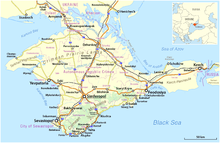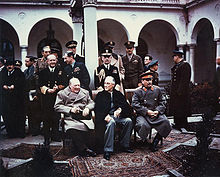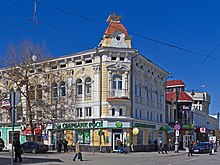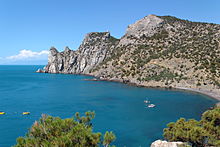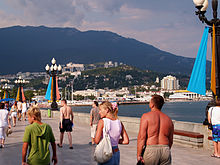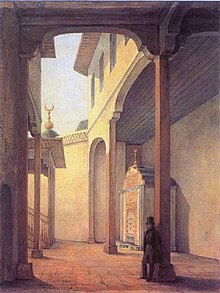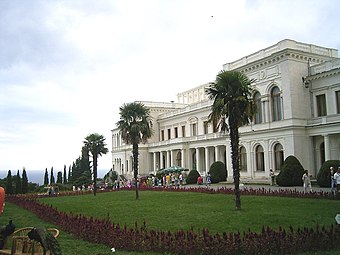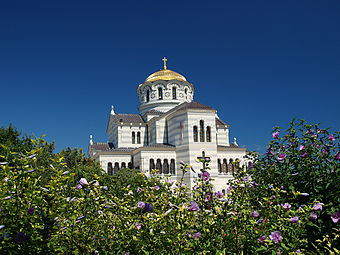
May 2015 satellite image of the Crimean Peninsula
| |
 | |
| Geography | |
|---|---|
| Location | Eastern Europe |
| Coordinates | 45.3°N 34.4°ECoordinates: 45.3°N 34.4°E |
| Adjacent bodies of water | |
| Largest city | Sevastopol |
| Area | 27,000 km2 (10,000 sq mi) |
| Highest elevation | 1,545 m (5,069 ft) |
| Administration | |
| Status | Controlled and governed as part of the Russian Federation (except Ukrainian-controlled part of Arabat Spit), though internationally recognised as part of Ukraine |
|
Ukraine (de jure)
| |
| Regions |
Autonomous Republic of Crimea (de jure) Sevastopol (de jure) Kherson Oblast (northern part of Arabat Spit, Henichesk Raion) |
|
Russia (de facto)
| |
| Federal district | Southern Federal District |
| Federal subjects |
Republic of Crimea Sevastopol |
| Demographics | |
| Demonym | Crimean |
| Population | 2,284,000 (2014 census) |
| Pop. density | 84.6 /km2 (219.1 /sq mi) |
| Ethnic groups |
65.3% Russians (1.492 mln) 15.1% Ukrainians (344.5 thousand) 10.8% Crimean Tatars (246.1 thousand) 0.9% Belarusians (21.7 thousand) 0.5% Armenians (11 thousand) 7.4% Others (169.1 thousand), including: Pontic Greeks Krymchaks Crimean Karaites Ashkenazi Jews Crimea Germans (2014) |
Map of the Crimean Peninsula
Crimea (/kraɪˈmiːə/; Russian: Крым, Ukrainian: Крим, Krym; Krym; Crimean Tatar: Къырым, translit. Qırım; Turkish: Kırım; Ancient Greek: Κιμμερία/Ταυρική, translit. Kimmería/Taurikḗ) is a peninsula on the northern coast of the Black Sea in Eastern Europe that is almost completely surrounded by both the Black Sea and the smaller Sea of Azov to the northeast. It is located south of the Ukrainian region of Kherson, to which it is connected by the Isthmus of Perekop, and west of the Russian region of Kuban, from which it is separated by the Strait of Kerch though now linked by the Crimean Bridge. The Arabat Spit is located to the northeast, a narrow strip of land that separates a system of lagoons named Sivash from the Sea of Azov. Across the Black Sea to its west is Romania and to its south Turkey.
Crimea (or the Tauric Peninsula, as it was called from antiquity until the early modern period) has historically been at the boundary between the classical world and the Pontic–Caspian steppe. Its southern fringe was colonised by the Greeks, the Persians, the Romans, the Byzantine Empire, the Crimean Goths, the Genoese and the Ottoman Empire, while at the same time its interior was occupied by a changing cast of invading steppe nomads and empires, such as the Cimmerians, Scythians, Sarmatians, Goths, Alans, Bulgars, Huns, Khazars, Kipchaks, Mongols and the Golden Horde. Crimea and adjacent territories were united in the Crimean Khanate during the 15th to 18th century.
In 1783, Crimea became a part of the Russian Empire as the result of the Russo-Turkish War (1768–1774). Following the Russian Revolution of 1917, Crimea became an autonomous republic within the Russian Soviet Federative Socialist Republic in the USSR. During World War II, Crimea was downgraded to the Crimean Oblast and then, in 1954, it was transferred to the Ukrainian SSR from the Russian SFSR.
With the collapse of the Soviet Union, Ukraine was formed as an independent state in 1991 and most of the peninsula was reorganized as the Autonomous Republic of Crimea, while the city of Sevastopol retained its special status within Ukraine. The 1997 Partition Treaty on the Status and Conditions of the Black Sea Fleet partitioned the former Soviet Black Sea Fleet and allowed Russia to continue basing its fleet in Crimea: both the Ukrainian Naval Forces and Russian's Black Sea Fleet were to be headquartered in Sevastopol. Ukraine extended Russia's lease of the naval facilities under the 2010 Kharkiv Pact in exchange for further discounted natural gas.
In March 2014, following the Ukrainian revolution and subsequent takeover of the territory by pro-Russian separatists and Russian Armed Forces, a referendum, deemed unconstitutional by the Ukrainian Constitutional Court, was held on whether to leave Ukraine and join Russia; the official result was that a large majority of Crimeans wished to join with Russia. Russia then incorporated the Republic of Crimea and the federal city of Sevastopol as federal subjects of Russia. While Russia and ten other UN member states recognize Crimea as part of the Russian Federation, Ukraine continues to claim Crimea as an integral part of its territory, supported by most foreign governments and non-binding United Nations General Assembly Resolution 68/262.
Name
The classical name Tauris or Taurica is from the Greek Ταυρική, after the peninsula's Scytho-Cimmerian inhabitants, the Tauri.Strabo (Geography vii 4.3, xi.2.5), Polybius, (Histories 4.39.4), and Ptolemy refer to the Strait of Kerch as the Κιμμερικὸς Βόσπορος (romanized spellings, Kimmerikos Bosporos, Bosporus Cimmerius), and to Cimmerium as the capital of the Taurida, whence the peninsula, and so also its easternmost part was named Promontorium Cimmerium (Κιμμέριον Ἄκρον).
In English usage since the early modern period the Crimean Khanate is referred to as Crim Tartary. The Italian form Crimea (and "Crimean peninsula") also becomes current during the 18th century, gradually replacing the classical name of Tauric Peninsula in the course of the 19th century. The omission of the definite article in English ("Crimea" rather than "the Crimea") became common during the later 20th century.
The name "Crimea" follows the Italian form from the Crimean Tatar name for the city Qırım (today's Stary Krym) which served as a capital of the Crimean province of the Golden Horde. The name of the capital was extended to the entire peninsula at some point during Ottoman suzerainty. The origin of the word Qırım is uncertain. Suggestions argued in various sources include:
- a corruption of Cimmerium (Greek, Kimmerikon, Κιμμερικόν).
- a derivation from the Turkic term qirum ("fosse, trench"), from qori- ("to fence, protect").
- a derivation from the Greek Cremnoi (Κρημνοί, in post-classical Koiné Greek pronunciation, Crimni, i.e., "the Cliffs", a port on Lake Maeotis (Sea of Azov) cited by Herodotus in The Histories 4.20.1 and 4.110.2).
However, he identifies the port not in Crimea, but as being on the
west coast of the Sea of Azov. No evidence has been identified that this
name was ever in use for the peninsula.
- The Turkic term is related to the Mongolian appellation kerm "wall", but sources indicate that the Mongolian appellation of the Crimean peninsula of Qaram is phonetically incompatible with kerm/kerem and therefore deriving from another original term.
History
Ancient history
Ruins of ancient Greek colony of Chersonesos
Swallow's Nest, built in 1912 for businessman Baron Pavel von Steingel
The peninsula, then under the control of the Bosporan Kingdom, later became a client kingdom of the Roman Empire in 63 BC.
Medieval history
In the 9th century CE, Byzantium established the Theme of Cherson to defend against incursions by the Rus' Khaganate. The Crimean peninsula from this time was contested between Byzantium, Rus' and Khazaria. The area remained the site of overlapping interests and contact between the early medieval Slavic, Turkic and Greek spheres. It became a center of slave trade. Slavs were sold to Byzantium and other places in Anatolia and the Middle-East during this period.Trapezuntine Perateia had already been subjected to pressure from the Genoese and Kipchaks by the time Alexios I of Trebizond died in 1222 before the Mongol invasions swept through in 1223. With them, the peninsula's status quo changed in the 1230s, as all but the Perateia of Crimea was incorporated into the territory of the Golden Horde throughout the 14th century CE. In the course of the 13th century CE, portions were controlled by the Republic of Venice and by the Republic of Genoa, the Perateia soon became the Principality of Theodoro and Genoese Gazaria, respectively.
Armenian monastery of the Holy Cross (Սուրբ Խաչ, Surb Khach), established in 1358
Crimean Khanate (1449–1783)
The Crimean Khanate, a vassal state of the Ottoman Empire, succeeded the Golden Horde and lasted from 1449 to 1783. In 1571, the Crimean Tatars attacked and sacked Moscow, burning everything but the Kremlin. Until the late 18th century, Crimean Tatars maintained a massive slave trade with the Ottoman Empire, exporting about 2 million slaves from Russia and Ukraine over the period 1500–1700.Russian Empire (1783–1917)
In 1774, the Khanate was proclaimed independent under the Treaty of Küçük Kaynarca with the Ottomans, but was then conquered by the Russian Empire in 1783.The Taurida Oblast was created by a decree of Catherine the Great on 2 February 1784. The center of the oblast was first in Karasubazar but was moved to Simferopol later in 1784. The establishment decree divided the oblast into 7 uyezds. However, by a decree of Paul I on 12 December 1796, the oblast was abolished and the territory, divided into 2 uyezds (Akmechetsky [Акмечетский] and Perekopsky [Перекопский]) was attached to the second incarnation of the Novorossiysk Governorate.
The eleven-month siege of a Russian naval base at Sevastopol during the Crimean War
From 1853 to 1856, the peninsula was the site of the principal engagements of the Crimean War, a conflict fought between the Russian Empire and an alliance of France, Britain, the Ottoman Empire and Sardinia.
Russian Civil War (1917–1921)
Following the Russian Revolution of 1917, the military and political situation in Crimea was chaotic like that in much of Russia. During the ensuing Russian Civil War, Crimea changed hands numerous times and was for a time a stronghold of the anti-Bolshevik White Army. The White Army controlled Crimea before remnants were finally driven out by the Red Army in November 1920. It was in Crimea that the White Russians led by General Wrangel made their last stand against Nestor Makhno and the Red Army. When resistance was crushed, many of the anti-Communist fighters and civilians escaped by ship to Istanbul. Between 56,000 and 150,000 of the Whites were murdered as part of the Red Terror.Soviet Union (1921–1991)
Crimea became part of the Russian Soviet Federative Socialist Republic in 1921 as the Crimean Autonomous Soviet Socialist Republic, which became part of the Soviet Union in 1922.Russian Soviet Federative Socialist Republic (1921–1954)
The "Big Three" at the Yalta Conference in Crimea: Winston Churchill, Franklin D. Roosevelt, and Joseph Stalin.
The Artek youth camp was created in 1925. During the Second World War the peninsula was invaded by Nazi Germany and Romanian troops in summer 1941 across the Isthmus of Perekop. Following the capture of Sevastopol on 4 July 1942, Crimea was occupied until German and Romanian forces were expelled in an offensive by Soviet forces ending in May 1944. On 25 June 1946, it was downgraded to the Crimean Oblast, and the Crimean Tatars were deported for alleged collaboration with the Nazi forces. A total of more than 230,000 people – about a fifth of the total population of the Crimean Peninsula at that time – were deported, mainly to Uzbekistan. 14,300 Greeks, 12,075 Bulgarians, and about 10,000 Armenians were also expelled.
Ukrainian Soviet Socialist Republic (1954–1991)
On 19 February 1954, the Presidium of the Supreme Soviet of the USSR issued a decree on the transfer of the Crimean region of the RSFSR to the Ukrainian SSR. This Supreme Soviet Decree states that this transfer was motivated by "the commonality of the economy, the proximity, and close economic and cultural relations between the Crimean region and the Ukrainian SSR". At that time no vote or referendum took place, and Crimean population had no say in the transfer (also typical of other Soviet border changes). After the annexation of Crimea by the Russian Federation, doubts have been expressed - from the Russian side by all means, but even by Western historians (Richard Sakwa, "Frontline Ukraine. Crisis In the Borderlands", 2015) - about the very legitimacy of the 1954 transition of Crimea to Ukraine; in the critics' view the transition contradicted even the Soviet law.In post-war years, Crimea thrived as a tourist destination, with new attractions and sanatoriums for tourists. Tourists came from all around the Soviet Union and neighbouring countries, particularly from the German Democratic Republic. In time the peninsula also became a major tourist destination for cruises originating in Greece and Turkey. Crimea's infrastructure and manufacturing also developed, particularly around the sea ports at Kerch and Sevastopol and in the oblast's landlocked capital, Simferopol. Populations of Ukrainians and Russians alike doubled, with more than 1.6 million Russians and 626,000 Ukrainians living on the peninsula by 1989.
Ukrainian Republic (1991–2014)
Simferopol's city centre
In January 1991, a referendum was held in the Crimean Oblast, and voters approved restoring the Crimean Autonomous Soviet Socialist Republic. However, after the dissolution of the Soviet Union less than a year later, the Autonomous Republic of Crimea was formed as a constituent entity of independent Ukraine, with a slight majority of Crimean voters approving Ukrainian independence in a December referendum. On 5 May 1992, the Crimean legislature declared conditional independence, but a referendum to confirm the decision was never held amid opposition from Kiev, elected president of Crimea Yuriy Meshkov, was replaced by Kiev appointed Anatoliy Franchuk, which was done with the intent to rein in Crimean aspirations of autonomy. The Verkhovna Rada voted to grant Crimea "extensive home rule" during the dispute.
Budapest Memorandum on Security Assurances acknowledged Ukrainian integrity.
The last election of the Verkhovna Rada of Crimea, the parliament of Crimea, took place on 31 October 2010 and was won by the Party of Regions. On 15 March 2014, the Verkhovna Rada of Ukraine officially dissolved the Verkhovna Rada of Crimea, and, on 17 March 2014, one day before the Russian annexation of Crimea, the State Council of Crimea was established in place of the Verkhovna Rada of Crimea.
Russian Federation administration (2014-present)
After the 2014 Ukrainian revolution and flight of Ukrainian President Viktor Yanukovych from Kiev on 21 February 2014, Russian President, Vladimir Putin stated to colleagues that "we must start working on returning Crimea to Russia." Within days, unmarked forces with local militias took over the Autonomous Republic of Crimea and Sevastopol, as well as occupying several localities in Kherson Oblast on the Arabat Spit, which is geographically a part of Crimea. Following a controversial referendum, the official results of which showed majority support for joining Russia, Russian President Vladimir Putin signed a treaty of accession with the self-declared Republic of Crimea, annexing it into the Russian Federation as two federal subjects: the Republic of Crimea and the federal city of Sevastopol. Though Russia had control over the peninsula, sovereignty was disputed as Ukraine and the majority of the international community consider the annexation illegal, as was shown by the United Nations General Assembly adopting a non-binding resolution calling upon states not to recognise changes to the integrity of Ukraine. A range of international sanctions have remained in place against Russia and a number of named individuals as a result of the events of 2014.
June 2015: Tourists in Crimea with Russian flag flying
Russia withdrew its forces from southern Kherson in December 2014 Since Russian control over Crimea was established in 2014, the peninsula has been administered as part of the Russian Federation except for the northern areas of the Arabat Spit and the Syvash which are still controlled by Ukraine.
Within days of the signing of the accession treaty, the process of integrating Crimea into the Russian federation began: in March the Russian ruble went into official circulation and clocks were moved forward to Moscow time, in April a new revision of the Russian Constitution was officially released with the Republic of Crimea and the federal city of Sevastopol included in the list of federal subjects of the Russian Federation, and in June the Russian ruble became the only form of legal tender. In July 2015, Russian Prime Minister Dmitry Medvedev stated that Crimea had been fully integrated into Russia.
Since 2014, the Russian government has been investing heavily in the peninsula’s infrastructure—repairing roads, modernizing hospitals and building the Crimean Bridge that links the peninsula to the Russian mainland. New sources of water have been developed to replace closed Ukrainian sources, and Crimea's electrical infrastructure has been replaced with Russian energy sources. It has also modernised the Simferopol International Airport.
Languages
According to Article 10 of the Constitution of the Republic of Crimea, there are three official languages in the republic: Russian, Ukrainian and Crimean Tatar. However, in practice, Russian is by far the main language.The history of Crimea is complex as it lies at a conjunction of European and Asian peoples, with a mosaic of distinct and affiliated ethnic communities. From the ancient period to the medieval period, the principal ethnic communities classed by linguistic origins are:
The Indo-European language family:
- The Iranian language group comprising the Cimmerians, Scythians, Sarmatians, and the Alans
- The Greek language group comprising the Greeks, Byzantines, and the Spartocids (hellenized)
- The Italic language group comprising the Romans, Venetians, and the Genoese
- The Germanic language group comprising the Goths, Ashkenazi Jews
- The Slavic language group comprising the Slavs
- The Armenian language group comprising the Armenians
- The Semitic language group comprising the Jews
The Mongolic family is represented by the Mongols
The Huns were of uncertain linguistic origins.
From the medieval period to the early modern period additional ethnic communities migrated to the area, prominent representation includes the Armenian, German, Serbian, and Jewish ethnic communities.
Geography
Geography of Crimea
Covering an area of 27,000 km2 (10,425 sq mi), Crimea is located on the northern coast of the Black Sea and on the western coast of the Sea of Azov, the only land border is shared with Ukraine's Kherson Oblast from the north. Crimea is almost an island and only connected to the continent by the Isthmus of Perekop, a strip of land about 5–7 kilometres (3.1–4.3 mi) wide.
The natural border between the Crimean Peninsula and the Ukrainian mainland is formed by the Sivash or "Rotten Sea", a large system of shallow lagoons between Russia by Kerch Strait. Beside isthmus of Perekop, the peninsula is connected to the Kherson Oblast's Henichesk Raion bridges over the narrow Chonhar and Henichesk straits and Kerch Strait to the Krasnodar Krai. The northern part of Arabat Spit is administratively part of Henichesk Raion in Kherson Oblast, including its two rural communities of Shchaslyvtseve and Strilkove. The eastern tip of the peninsula is the Kerch Peninsula, separated from Taman Peninsula on the Russian mainland by the Kerch Strait, which connects the Black Sea with the Sea of Azov, at a width of between 3–13 kilometres (1.9–8.1 mi).
Geographically, the peninsula is generally divided into three zones: steppe, mountains and southern coast.
Coastline
South coast of Crimea
The Crimean peninsula comprises many smaller peninsulas, such as the mentioned Kerch peninsula, Heracles Peninsula, Tarkhankut Peninsula and many others. Crimea also possesses lots of headlands such as Cape Priboiny, Cape Tarkhankut, Sarych, Cape Fonar, Kazantyp, Cape Akburun, and many others.
The Crimean coastline is broken by several bays and harbors. These harbors lie west of the Isthmus of Perekop by the Bay of Karkinit; on the southwest by the open Bay of Kalamita between the port cities of Yevpatoria and Sevastopol.
The Kerch Peninsula is attached to the Crimean mainland by Isthmus of Yenikale, delimited by the Bay of Arabat to the north (interrputed by the incoming Arabat Spit), and the Bay of Caffa to the south (arching eastward from the port of Feodosiya).
Crimean Mountains
Eclizee-Burun Mountain
The southeast coast is flanked at a distance of 8–12 kilometres (5.0–7.5 mi) from the sea by a parallel range of mountains, the Crimean Mountains. These mountains are backed by secondary parallel ranges.
The main range of these mountains shoots up with extraordinary abruptness from the deep floor of the Black Sea to an altitude of 600–1,545 metres (1,969–5,069 ft), beginning at the southwest point of the peninsula, called Cape Fiolente. It was believed that this cape was supposedly crowned with the temple of Artemis, where Iphigeneia is said to have officiated as priestess. Uchan-su, on the south slope of the mountains, is the highest waterfall in Crimea.
Hydrography
There are 257 rivers and major streams on the Crimean peninsula which are primarily fed by rainwater, with snowmelt playing a very minor role. This means there is significant annual fluctuation in water flow with many streams drying up completely during the summer. The largest rivers are the Salhir (Salğır, Салгир), the Kacha (Кача), the Alma (Альма), and the Belbek (Бельбек). Also important are the Kokozka (Kökköz or Коккозка), the Indole (Indol or Индо́л), the Chorna (Çorğun, Chernaya or Чёрная), the Derekoika (Dereköy or Дерекойка), the Karasu-Bashi (Biyuk-Karasu or Биюк-Карасу) (tributary of Salhir river), the Burulcha (Бурульча) (tributary of Salhir river), the Uchan-su, and the Ulu-Uzen'. The longest river of Crimea is the Salhir at 204 km. The Belbek has the greatest average discharge at 2.16 cubic metres per second (76 cu ft/s). The Alma and the Kacha are the second and third longest rivers.There are more than fifty salt lakes and salt pans on the peninsula, the largest of them is Lake Sasyk (Сасык) on the southwest coast, but others include Aqtas, Koyashskoye, Kiyatskoe, Kirleutskoe, Kizil-Yar, Bakalskoe, and Donuzlav. The general trend is for the former lakes to become salt pans. Lake Syvash (Sıvaş or Сива́ш) is a system of interconnected shallow lagoons on the northern coast, which covers an area of around 2,560 km2. There are a number of dams that have created reservoirs, among the largest are the Simferopolskoye, Alminskoye, the Taygansky and the Belogorsky just south of Bilohirsk in Bilohirsk Raion. The North Crimea Canal, which transports water from the Dnieper, is the largest of the man-made irrigation channels on the peninsula.
Steppe
Seventy-five percent of the remaining area of Crimea consists of semiarid prairie lands, a southward continuation of the Pontic-Caspian steppe, which slope gently to the northwest from the foot of the Crimean Mountains. Numerous kurgans, or burial mounds, of the ancient Scythians are scattered across the Crimean steppes.Crimean Riviera
The Crimean Mountains and the southern coast are part of the Crimean Submediterranean forest complex ecoregion. The natural vegetation consists of scrublands, woodlands, and forests, with a climate and vegetation similar to the Mediterranean Basin.
Climate
Crimea's south coast has a subtropical climate
Crimea is located between the temperate and subtropical climate belts and is characterized by warm and sunny weather. It is characterized by the diversity and presence of microclimates. The northern parts of Crimea have a moderate continental climate with short, mild winters and moderately hot dry summers. In the central and mountainous areas, the climate is transitional between the continental climate to the north and the Mediterranean climate to the south. Winters are mild at lower altitudes (in the foothills) and colder at higher altitdues. Summers are hot at lower altitudes and warm in the mountains. A subtropical, Mediterranean climate is found in the southern coastal regions, and is characterized by mild winters and moderately hot, dry summers.
The climate of Crimea is influenced by its geographic location, relief, and influences from the Black sea. The Crimean coast is shielded from cold air masses coming from north and as a result has milder winters. Maritime influences from the Black Sea are restricted to coastal areas; inside the peninsula, the influence is weak and does not play an important role. Because a high pressure system is located north of Crimea in both summer and winter, winds predominantly come from the north and northeast year-round. In winter, these winds bring in cold, dry continental air while in summer, it brings in dry and hot weather. Winds from the northwest bring warm and wet air from the Atlantic Ocean and are responsible for bringing precipitation during spring and summer. As well, winds from the southwest bring very warm and wet air from the subtropical latitudes of the Atlantic Ocean and the Mediterranean sea and are responsible for bringing precipitation during fall and winter.
Mean annual temperatures range from 10 °C (50.0 °F) in the far north (Armiansk) to 13 °C (55.4 °F) in the far south (Yalta). In the mountains, the mean annual temperature is around 5.7 °C (42.3 °F). For every 100 m (330 ft) increase in altitude, temperatures decrease by 0.65 °C (1.17 °F) while precipitation increases. In January, mean temperatures range from −3 °C (26.6 °F) in Armiansl to 4.4 °C (39.9 °F) in Myskhor. Cool season temperatures average around 7 °C (44.6 °F) and it is rare for the weather to drop below freezing except in the mountains, where there is usually snow. In July, mean temperatures range from 15.4 °C (59.7 °F) in Ai-Petri to 23.4 °C (74.1 °F) in the central parts of Crimea to 24.4 °C (75.9 °F) in Myskhor. The frost free period ranges from 160–200 days in the steppe and mountains regions to 240–260 days on the south coast.
Precipitation in Crimea varies significantly based on location; it ranges from 310 millimetres (12.2 in) in Chornomorske to 1,220 millimetres (48.0 in) at the highest altitudes in the Crimean mountains. The Crimean mountains greatly influence the amount of precipitation present in the peninsula. However, most of Crimea (88.5%) receives 300 to 500 millimetres (11.8 to 19.7 in) of precipitation per year. The plains usually receive 300 to 400 millimetres (11.8 to 15.7 in) of precipitation per year, increasing to 560 millimetres (22.0 in) in the southern coast at sea level. The western parts of the Crimean mountains receive more than 1,000 millimetres (39.4 in) of precipitation per year. Snowfall is predominant in the mountains during winter.
Most of the peninsula receives more than 2,000 sunshine hours per year; it reaches up to 2,505 sunshine hours in Karabi–Yayla in the Crimean mountains. As a result, the climate is favorable for recreation and tourism. Because of its climate and subsidized travel packages from Russian state-run companies, the southern Crimean coast has remained a popular resort for Russian tourists.
Strategic value
Map of the historical trade route (shown in purple) connecting Uppsala with Constantinople via Cherson. The major centers of the Kievan Rus', Kiev itself, Novgorod and Ladoga, arose along this route.
The Black Sea ports of Crimea provide quick access to the Eastern Mediterranean, Balkans and Middle East. Historically, possession of the southern coast of Crimea was sought after by most empires of the greater region since antiquity (Roman, Byzantine, Ottoman, Russian, British and French, Nazi German, Soviet).
The Dnieper River is a major waterway and transportation route that crosses the European continent from north to south and ultimately links the Black Sea with the Baltic Sea, of strategic importance since the historical trade route from the Varangians to the Greeks. The Black Sea serves as an economic thoroughfare connecting the Caucasus region and the Caspian Sea to central and Eastern Europe.
According to the International Transport Workers' Federation, in 2013 there were at least 12 operating merchant seaports in Crimea.
Economy
Tourism is an important sector of Crimea's economy
In 2016 Crimea had Nominal GDP of US$ 6.7 billion and US$ 3,000 per capita.
The main branches of the modern Crimean economy are agriculture & fishing oysters pearls else, industry & manufacturing along mining and chemical, tourism, ports. Industrial plants are situated for the most part in the southern coast (Eupatoria Sevastopol Feodosia Kerch) regions of the republic, few northern (Armyansk Krasnoperekopsk Dzhankoj), aside central area, mainly Simferopol okrug and eastern region in Nizhnegorsk (few plants, same for Dzhankoj) city . Important industrial cities include Dzhankoy, housing a major railway connection, Krasnoperekopsk and Armyansk, among others.
After the Russian annexation of Crimea in early 2014 and subsequent sanctions targeting Crimea, the tourist industry suffered major losses for two years. The flow of holidaymakers dropped 35 percent in the first half of 2014 over the same period of 2013. The number of tourist arrivals reached a record in 2012 at 6.1 million. According to the Russian administration of Crimea, they dropped to 3.8 million in 2014, and rebounded to 5.6 million by 2016.
The most important industries in Crimea include food production, chemical fields, mechanical engineering and metal working, and fuel production industries. Sixty percent of the industry market belongs to food production. There are a total of 291 large industrial enterprises and 1002 small business enterprises.
Agriculture in the region includes cereals, vegetable-growing, gardening, and wine-making, particularly in the Yalta and Massandra regions. Livestock production includes cattle breeding, poultry keeping, and sheep breeding. Other products produced on the Crimean Peninsula include salt, porphyry, limestone, and ironstone (found around Kerch) since ancient times.
In 2014, the republic's annual GDP was $4.3 billion (500 times smaller than the size of Russia's economy). The average salary was $290 per month. The budget deficit was $1.5 billion.
Energy
Crimea also possesses several natural gas fields both onshore and offshore, which were starting to be drilled by western oil and gas companies before annexation. The inland fields are located in Chornomorske and Dzhankoy, while offshore fields are located in the western coast in the Black Sea and in the northeastern coast in the Azov Sea:The republic also possesses two oil fields: one onshore, the Serebryankse oil field in Rozdolne, and one offshore, the Subbotina oil field in the Black Sea.
- Electricity
Building and near start up are two combined cycle gas steam turbo thermal plants PGU, both 470 MW (116 167 MW GT, 235 MW block), build (plant) by TPE along others and turbines by Power Machines (UTZ KalugaTZ ?), NPO Saturn with Perm PMZ, either GTD-110M modified or GTE-160 or 180 units or UTZ KTZ or a V94.2 bought by MAPNA, modified in Russian plants for PGU Thermal plants specifics. Also many solar photovoltaic SES plants lie along the peninsula (north of Sevastopol too, a smaller facility). Also gas thermal Saki plant close to Jodobrom chemical plant and SaKhZ(SaChP) boosted production with Perm GTE GTU25P (PS90GP25 25 MW aeroderivative GP) PGU turbogenerators. Older plants are Sevastopol TEC (close to Inkerman) which use AEG and Ganz Elektro turbines and turbogenerators abot 25 MW each, Sinferopol TEC (north, in Agrarne locale) Eupatoria, Kamysh Burun TEC (Kerch south - Zaliv) and few others.
Infrastructure
Trolleybus near Alushta
The cableway in Yalta
- Crimean Bridge
- Public transportation
Railroad lines running through Crimea include Armyansk—Kerch (with a link to Feodosiya), and Melitopol—Sevastopol (with a link to Yevpatoria), connecting Crimea to the Ukrainian mainland.
- International airport
- Simferopol International Airport's new terminal opened in from April 2018 with the ability to handle 6.5 million passengers a year. It was built in 22 months and covers an area of 78,000 square meters.
- Highways
- (building) Tavrida highway (route (Eupatoria-)Sevastopol - Simferopol (SW to W N to East ring) - Belogorsk
- north Feodosia - Kerch south (strait bridge) . - E105/M18 – Syvash (bridge, starts), Dzhankoy, North Crimean Canal (bridge), Simferopol, Alushta, Yalta (ends)
- E97/M17 – Perekop (starts), Armyansk, Dzhankoy, Feodosiya, Kerch (ferry, ends)
- H05 – Krasnoperekopsk, Simferopol (access to the Simferopol International Airport)
- H06 – Simferopol, Bakhchisaray, Sevastopol
- H19 – Yalta, Sevastopol
- P16
- P23 – Simferopol, Feodosiya
- P25 – Simferopol, Yevpatoria
- P27 – Sevastopol, Inkerman (completely within the city of Sevastopol)
- P29 – Alushta, Sudak, Feodosiya
- P34 – Alushta, Yalta
- P35 – Hrushivka, Sudak
- P58 – Sevastopol, Port "Komysheva Bukhta" (completely within the city of Sevastopol)
- P59 (completely within the city of Sevastopol)
- Railways
- Armyansk Dzhankoi, Dzhankoi Sinferopol, Eupatoria Sinferopol
- Sevastopol Sinferopol, Dzhankoi Nezhgorsk (Feodosia) Kerch, Kerch (bridge) Taman Krasnodar
- project building shortcut north Simferopol south Nezhgorsk or Sinferopol Belogorsk (Feodosia) Kerch route
- Sea transport
Tourism
Boardwalk in Yalta.
Mosque and yard in the Khan Palace in Bakhchisaray
The development of Crimea as a holiday destination began in the second half of the 19th century. The development of the transport networks brought masses of tourists from central parts of the Russian Empire. At the beginning of the 20th century, a major development of palaces, villas, and dachas began—most of which remain. These are some of the main attractions of Crimea as a tourist destination. There are many Crimean legends about famous touristic places, which attract the attention of tourists.
A new phase of tourist development began when the Soviet government realised the potential of the healing quality of the local air, lakes and therapeutic muds. It became a "health" destination for Soviet workers, and hundreds of thousands of Soviet tourists visited Crimea.
Artek is a former Young Pioneer camp on the Black Sea in the town of Hurzuf, near Ayu-Dag, established in 1925. In 1969 it had an area of 3.2 km². The camp consisted of 150 buildings Unlike most of the young pioneer camps, Artek was an all-year camp, due to the warm climate. Artek was considered to be a privilege for Soviet children during its existence, as well as for children from other communist countries. During its heyday, 27,000 children a year vacationed at Artek. Between 1925 and 1969 the camp hosted 300,000 children. After the breaking up of the Young Pioneers in 1991 its prestige declined, though it remained a popular vacation destination.
In the 1990s, Crimea became more of a get-away destination than a "health-improvement" destination. The most visited areas are the south shore of Crimea with cities of Yalta and Alushta, the western shore – Eupatoria and Saki, and the south-eastern shore – Feodosia and Sudak. According to National Geographic, Crimea was among the top 20 travel destinations in 2013.
Places of interest include
Sanctions
Following Russia's largely unrecognized annexation of Crimea, the European Union, the United States, Canada, Australia, Japan, and several other countries (including Ukraine) imposed economic sanctions against Russia, including some specifically targeting Crimea. Many of these sanctions were directed at individuals—both Russian and Crimean. In general they prohibit the sale, supply, transfer, or export of goods and technology in several sectors, including services directly related to tourism and infrastructure. They list seven ports where cruise ships cannot dock. Sanctions against individuals include travel bans and asset freezes. Visa and MasterCard stopped service in Crimea in December 2014. To get around this, a new Russian national payment card system started on 1 April 2015, which allowed Visa and MasterCard cards issued by Russian banks to work in the Crimea. The Mir (payment system) operated by the Central Bank of Russia is now functioning as well as Master Card and Visa. However, there are no major international banks in the Crimea.Politics
The politics of Crimea is that of the Republic of Crimea on one hand, and that of the federal city of Sevastopol on the other. Since becoming the 84th and 85th Federal Subjects of the Russian Federation in 2014, both have strongly supported United Russia in both local and national elections.At the most recent Crimean parliamentary election on 14 September 2014, United Russia won 70 of the 75 seats in the State Council of Crimea based on just over 70% of the vote. Despite calls from local Crimean Tatars for a boycott of the elections, turnout was over 53% which compared well with elections in other regions of Russia. Following the election, Sergey Aksyonov became Head of the Republic of Crimea: he had previously been Acting Head from 14 April 2014. United Russia is also the leading party in the Legislative Assembly of Sevastopol having won 22 of the 24 seats at the last election. The Governor of Sevastopol is Dmitry Ovsyannikov who was first appointed on 28 July 2016 following the resignation of Sergey Menyaylo, and secured re-election on 71% of the vote on 10 September 2017.
United Russia maintained its position as the most supported political party across Crimea at the Russian legislative election on 18 September 2016, achieving 72.8% of the vote. At 49.1%, turnout was slightly ahead of that for Russia as a whole which was only 47.8%.
At the 2018 Russian presidential election, Vladimir Putin secured 92% of the vote in Crimea compared to 77% across Russia as a whole.
Demographics
As of 2014, the total population of the Republic of Crimea and Sevastopol was 2,248,400 people (Republic of Crimea: 1,889,485, Sevastopol: 395,000). This is down from the 2001 Ukrainian Census figure, which was 2,376,000 (Autonomous Republic of Crimea: 2,033,700, Sevastopol: 342,451).
The Foros Church near Yalta
According to the 2014 Russian census, 84% of Crimean inhabitants named Russian as their native language; 7.9% – Crimean Tatar; 3.7% – Tatar; and 3.3% – Ukrainian. It was the first official Russian census in Crimea since Ukrainian that held in 2001.
According to the 2001 census, 77% of Crimean inhabitants named Russian as their native language; 11.4% – Crimean Tatar; and 10.1% – Ukrainian. In 2013, however, the Crimean Tatar language was estimated to be on the brink of extinction, being taught in Crimea only in around 15 schools at that point. Turkey provided the greatest support to Tatars in Ukraine, which had been unable to resolve the problem of education in their mother tongue in Crimea, by bringing the schools to a modern state.
Ethnic composition of Crimea's population has changed dramatically since the early 20th century. The 1897 Russian Empire Census for the Taurida Governorate reported: 196,854 (13.06%) Crimean Tatars, 404,463 (27.94%) Russians and 611,121 (42.21%) Ukrainians. But these numbers included Berdyansky, Dneprovsky and Melitopolsky uyezds which were on mainland, not in Crimea.
Crimean Tatars, a predominantly Muslim ethnic minority who in 2001 made up 12.1% of the population, formed in Crimea in the late Middle Ages, after the Crimean Khanate had come into existence. The Crimean Tatars were forcibly expelled to Central Asia by Joseph Stalin's government as a form of collective punishment, on the grounds that they had formed pro-German Tatar Legions. After the fall of the Soviet Union, Crimean Tatars began to return to the region. According to the 2001 Ukrainian population census, 58% of the population of Crimea are ethnic Russians and 24% are ethnic Ukrainians.
Jews in Crimea were historically Krymchaks and Karaites (the latter a small group centered at Yevpatoria). The 1879 census for the Taurida Governorate reported a Jewish population of 4.20%, not including a Karaite population of 0.43%. The Krymchaks (but not the Karaites) were targeted for annihilation during Nazi occupation.
The number of Crimea Germans was 60,000 in 1939. During WWII, they were forcibly deported on the orders of Stalin, as they were regarded as a potential "fifth column". This was part of the 800,000 Germans in Russia who were relocated within the Soviet Union during Stalinist times.
The 2001 Ukrainian census reports just 2,500 ethnic Germans (0.1% of population) in Crimea.
Besides the Crimean Germans, Stalin in 1944 also deported 70,000 Greeks, 14,000 Bulgarians and 3,000 Italians.
Religion
In 2013, Orthodox Christians made up 58% of the Crimean population, followed by Muslims (15%) and believers in God without religion (10%).Culture
Alexander Pushkin in Bakhchisaray Palace. Painting by Grigory Chernetsov
Almost 100 broadcasters and around 1,200 publications are registered in Crimea, although no more than a few dozen operate or publish regularly. Of them most use the Russian language only. Crimea's first Tatar-owned, Tatar-language TV launched in 2006.
Alexander Pushkin visited Bakhchysarai in 1820 and later wrote the poem The Fountain of Bakhchisaray. Crimea was the background for Adam Mickiewicz's seminal work, The Crimean Sonnets inspired by his 1825 travel. A series of 18 sonnets constitute an artistic telling of a journey to and through the Crimea, they feature romantic descriptions of the oriental nature and culture of the East which show the despair of an exile longing for the homeland, driven from his home by a violent enemy.
Ivan Aivazovsky, the 19th-century marine painter of Armenian origin, who is considered one of the major artists of his era was born in Feodosia and lived there for the most part of his life. Many of his paintings depict the Black Sea. He also created battle paintings during the Crimean War.
Crimean Tatar singer Jamala won the Eurovision Song Contest 2016 representing Ukraine with her song 1944, about the historic deportation of Crimean Tatars in that year by Soviet authorities.
According to the, broken in practice by Russian companies, Ukrainian “law on concert activities” only Ukrainian companies can organise concerts in Crimea.
- Painting of the Russian squadron in Sevastopol by Ivan Aivazovsky (1846)
- The grave of Russian poet and artist Maximilian Voloshin
- People at the Kazantip music festival in 2007
Sport
Following Crimea's vote to join Russia and subsequent annexation in March 2014, the top football clubs withdrew from the Ukrainian leagues. Some clubs registered to join the Russian leagues but the Football Federation of Ukraine objected. UEFA ruled that Crimean clubs could not join the Russian leagues but should instead be part of a Crimean league system. The Crimean Premier League is now the top professional football league in Crimea.A number of Crimean born athletes have been given permission to compete for Russia instead of Ukraine at future competitions, including Vera Rebrik, the European javelin champion. Due to Russia currently being suspended from all international athletic competitions Rebrik participates in tournaments as a 'neutral' athlete.

